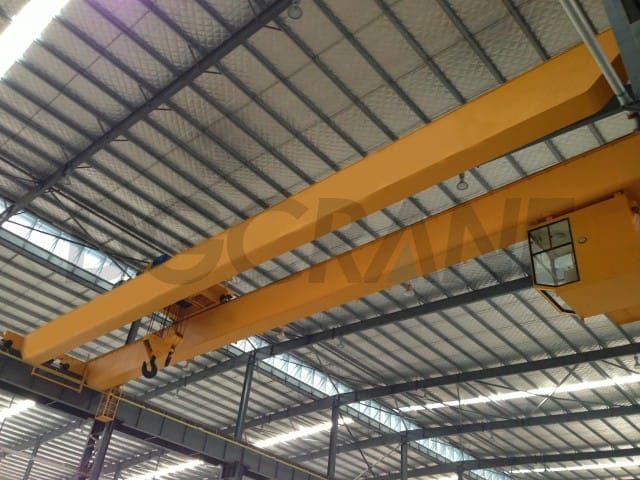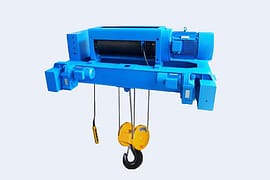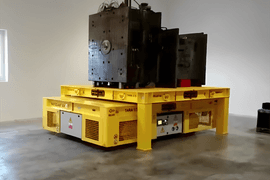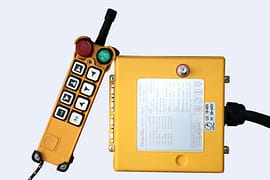How Do Overhead Crane Work – Levers, Pulleys, Hydraulic Cylinder And Mechanical Advantage
Have you ever marveled at modern technology? Although lots of modern technology and machinery are, in fact, very complicated, some are actually very sensible, once you weed out the bells and whistles.
The construction crane, for instance, is such a machine. The crane generally employs only three simple machines. The lever, the pulley, and the hydraulic cylinder.
Lever
In this article, we will briefly examine a very importance mechanism in the construction crane: the lever. Three subsequent articles, however, will investigate the role of the pulley, the hydraulic cylinder, and the concept of mechanical advantage, respectively, in construction cranes.
So, how do overhead crane work? To a greater or lesser extent, most cranes utilize the lever to lift exceptionally large loads. Almost all mounted cranes and many balanced cranes maximize lifting capacity with the lever.

These cranes use levers, or mechanical arms, that increase its strength. Although a complex system of ropes, chains, and pulleys usually accompany the mechanical arm, the lever itself is merely a simple machine.
The ancients have long used the lever in practice to build large temples, monuments, and fortifications. In fact, scholars contend that the Egyptians most likely used levers to construct the Great Pyramids.
However, most historians attribute the development of the geometric theory behind the lever to Archimedes. Archimedes, a Mathematician and Philosopher, lived in Ancient Greece around the third century B.C.E. Purportedly, he once quipped, “Give me a place to stand, and I shall move the Earth with a lever.”
The lever itself is a stable bar that rests on a pivot point, or fulcrum. You can press down on one end with some “effort” force to produce some resulting “work” force on the other end. The work force usually carries or holds the object being lifted.
Scientist classify all levers into three different groups. In class one levers, the fulcrum sits between the effort and work forces, as in a seesaw or crowbar. Class two levers are levers in which the the work force sits between the fulcrum and the effort force, like a wheelbarrow. And in class three levers, the effort force is applied between the fulcrum and the work force, as in tweezers.
But, again, how do overhead crane work? As we will see with the pulley and hydraulic cylinder, the lever manipulates a concept known as torque. Torque measures the distance over which a force is applied, or torque equals force times distance.
As Archimedes realized, manipulating torque provides greater lifting capacities. For example, consider a simple seesaw on a playground. The seesaw in ten feet long, and it pivots on a bar directly in the center of the seesaw board. One on side sits a 200 pound kid, and on the opposite side sits a scrawnier 100 pound kid.
The fatter kid will certainly push his side of the seesaw down to the ground, while the scrawny kid raises up. For the smaller kid, the must apply an extra 100 pounds of force to merely balance out the seesaw!
But what if he had magical abilities that allowed him to extend his side of the seesaw by 5 more feet. His ten-foot side of the seesaw, matched with his 100 pound weight, would allow him to balance the seesaw. And, theoretically, if he extended his side to a length greater than 10 feet, his side would slowly creep the ground, lifting the fatter kid off the ground.
Yet, again, how do overhead crane work? The lever, in part, manipulates torque allow cranes to lift very heavy loads. The more you spread the effort force over greater distances, the less “effort” force will be required to make the lift. Levers don’t only help scrawny children but also hundreds of engineers, architects, and construction workers who lift gigantic loads everyday!
Stay tuned for the next segment in our series “How do overhead crane work?”, when we will explore the role of the pulley. Then we will move on to the hydraulic cylinder and the concept of mechanical advantage.
Barnhart Crane and Rigging Company is always raising the bar in the crane industry. If you need a crane or wish to learn more, please visit the Crane Service and Machinery Moving pages on the Barnhart Crane website.
The pulley’s manipulation of torque
In my last article, I asked the question: how do overhead cranes work? To solve this enigma, I first investigated the significant role of the lever in construction cranes. Today, we will see that the pulley’s manipulation of torque, like the lever, increases a crane’s ability to lift heavy loads. In the following articles, we will explore hydraulic cylinders and the concept of mechanical advantage.
As with the lever, scholars credit Archimedes with the earliest theoretical development of the pulley. According to Plutarch, a Greek historian, Archimedes claimed that he could move the world if he had enough pulleys, a very similar statement to his proposal about moving the Earth with a lever. The story continues when King Hieron of Syracuse asks Archimedes to move a large ship in Hieron’s navy. On the appointed day, Archimedes set up his system of pulleys, the King loaded the ship full of passengers and cargo, and then Archimedes sat from a distance and pulled the rope. The result? Plutarch explains the shipped moved “as smoothly and evenly as if she had been in the sea.”
To the ancients, this was a mere novelty, but today, this is basic science. To explain it crudely, pulleys distribute weight through different segments of rope to make lifting heavy objects easier. Let’s say one has a large object he wishes to lift. He reaches down and attempts to lift it with his own strength, but he cannot do it. To make this easier, he attaches a pulley to the large load. Then he attaches a rope to the ceiling and pulls that rope through the pulley. Next, he lifts up on the rope, and finally lifts the object. One can do this because the rope on the ceiling supplies half of the force needed to lift the object while one applies the other half.
But why does this happen? The pulley distributes weight across two rope segments, the side of the rope from the ceiling to the pulley and the other side of the rope from the pulley to the lifter. This distribution is a manipulation of torque, as the lifter spreads the force across a longer distance. The ceiling, believe it or not, helps one lift the object, partly because we capitalize on the lifting capacity of the ceiling structure that holds the ceiling up, thus allowing the lifter to do only half of the work. One can continue to make the lift easier by adding more pulleys and to different places, but the math becomes a little more complicated. However, the general rule is as follows: the more pulleys, the more power.
Different configurations of pulleys, as a result, makes lifting easier. Three types of configurations, or types, of pulleys exist. A fixed pulley describes a pulley system where the axle or wheel is fixed, or immovable. The second type is a movable pulley, where the axle or wheel can move about freely. And the third type is a combined pulley, in which both fixed and movable pulleys are used. Fixed pulleys allow for easier configuration, but movable pulleys multiply the applied force, which makes work easier. Different situations call for different types of pulleys, as was the case with the lever.
But how does this apply to cranes? Well almost all cranes use pulleys, but the most common application of pulleys in cranes occur in jib cranes. Jib cranes have wires that wrap around pulleys and the load. The more you wrap the wires through the two, the higher the lifting capacity.
In the next segment of How Cranes Work? ?I will outline the importance of the hydraulic cylinder, after which, I will conclude with a subsequent and final article on the role of mechanical advantage.
Hydraulic cylinder and mechanical advantage
Now to part three in our series on the science behind construction cranes, in which we will consider the role of the hydraulic cylinder. The first two parts briefly described how levers and pulleys, respectively, contribute to the lifting force in cranes. The subsequent and final article will consider perhaps the most important scientific principle in maximizing lifting force: mechanical advantage.
So what is a hydraulic cylinder? The simple answer is a sealed cylinder, or a circular prism, that is fully filled with some type of liquid, normally an oil, with two openings for two pistons. The pistons may be connected to the cylinder in various configurations.
If we assume that the pistons are the same size in a hydraulic cylinder and there exist no friction, when one piston is pressed downward, the other will rise upward at an equal force, speed, and distance. So, if one compresses a piston downward two centimeters, the other piston should depress upward two centimeters.
The advantage of this system allows you to easily redirect forces. A piston attached horizontally can move another piston attached vertically, whereas other machines do not allow for such an easy translation of direction, as we saw with the pulleys and levers. With levers and pulleys, a force down will result in some force moving upward, and vice versa, and a force to the right will result in a force to the left, and vice versa. The hydraulic cylinder can allow for a force in one direction to be transferred to any possible direction, up, down, forward, backward, right, or left.
On the other hand, the hydraulic cylinder can multiply forces by maximizing torque, as we saw with the lever and pulley. If one piston has an area of 6 square units, and another piston has a 2 square units, then the force pushing down on the smaller piston will appear 3 times greater on the larger piston. For example, if one pushes the 2-square-unit piston down with a force of 500 pounds, then the 6-square-unit piston receive a push with the force of 1500 pounds. However, the distance the larger piston moves will be 3 times less than the distance the smaller piston moved to create 1500 pounds of force.
Also similar to the lever and pulley, almost all cranes utilize the hydraulic cylinder in some form or fashion. The crane may use a hydraulic cylinder to directly lift the load, but a hydraulic may be used to extenuate a crane arm or move a jib or beam that carries the lifting mechanism.
In conclusion, the hydraulic cylinder is much like the pulley and lever for its frequent use in cranes and its manipulation of torque. However, the hydraulic cylinder sets itself apart because of its ability to redirect forces to different planes. However, all three, the lever, pulley, and hydraulic cylinder, collectively maximize the mechanical advantage in lifting large objects. In the next installment, we will examine exactly what mechanical advantage is and how it’s applied to cranes.
























































































































